Bearcam 2015 ended with startling deaths that highlighted the harsh realities of a bear’s world. People rarely witness bears dying. When they do, it is usually at the paws of another bear. Over the last 30 years, relatively few bear deaths have been documented in Katmai. The death of two bears, a young cub and an adult male, offered the opportunity to learn from events that people rarely have the opportunity to observe and study. Below is a list of the most frequently asked questions about these deaths and the answers we have so far.
What happened?
On Wednesday, October 21, 2015 bearcam viewers watched a mother bear (451) and her two spring cubs. One of the cubs stumbled as it walked. The cub collapsed at the base of the viewing platform near one of the bearcams. For two and a half days, it remained there. 451 and her other cub remained nearby for most of this time. Viewers monitored the status of the bear, keeping counts on breaths per minute at the request of park employees. On Friday, October 23 at approximately 7:45 PM AKDT the cub expired. The cub was collected for necropsy on Saturday, October 24.
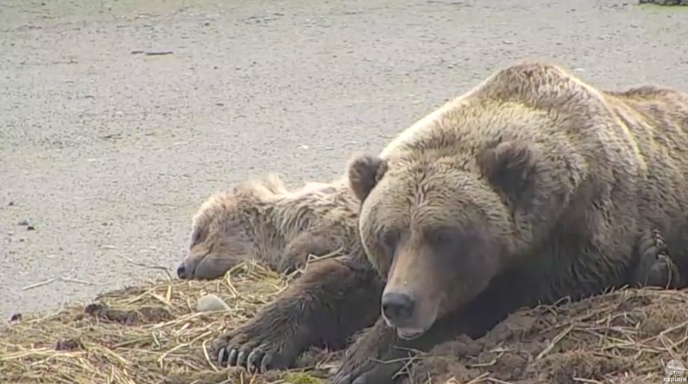 451 and her other cub remained near the dying cub for over two days. Screen capture from River Watch bearcam on explore.org.
451 and her other cub remained near the dying cub for over two days. Screen capture from River Watch bearcam on explore.org.
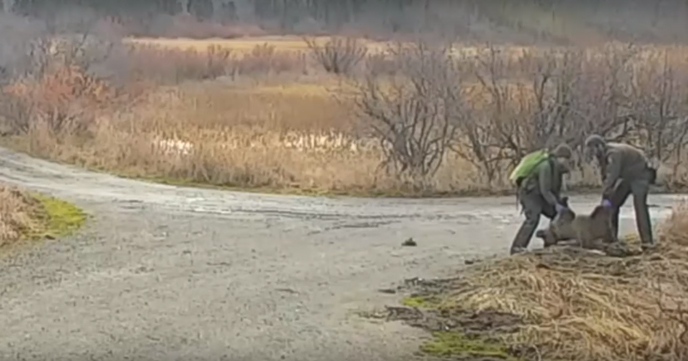 Biologists collected 451's dead cub as soon as they could retrieve it. Screen capture from River Watch bearcam on explore.org.
Biologists collected 451's dead cub as soon as they could retrieve it. Screen capture from River Watch bearcam on explore.org.
A few hours after the dead cub was retrieved, webcam viewers noticed a large, brown, stationary object at the lakeshore near where the cub died. It did not move in the following days. Due to its size, color, and location, park staff believed it was a dead bear. Since the possibility for a disease outbreak or human-caused deaths existed, park staff decided to return to Brooks River, conduct a gross field necropsy, and send samples to a lab for further analysis. Weather prevented biologists from getting to Brooks Camp to investigate until Wednesday, October 28, at which time they determined that the large brown object was an adult bear. When they arrived, wildlife technicians conducted a gross necropsy of the bear and identified it as 868, an adult male who was first seen as an independent bear at Brooks River in 2006.
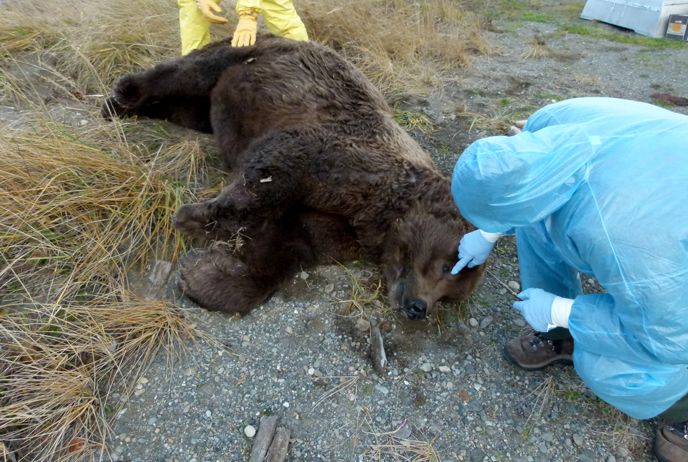 Biologists in personal protective equipment begin to examine 868’s body. NPS Photo/L Skora.
Biologists in personal protective equipment begin to examine 868’s body. NPS Photo/L Skora.
What killed the cub?
No signs of outward trauma were visible on the cub. Preliminary results from a laboratory analysis indicate that the cub likely died from canine adenovirus type-I (CAV-1). This disease is also called canine infectious hepatitis. The tissue samples from the cub tested negative for rabies and canine distemper. Other test results are pending. Analysis was conducted by USGS staff at the National Wildlife Health Center (NWHC).
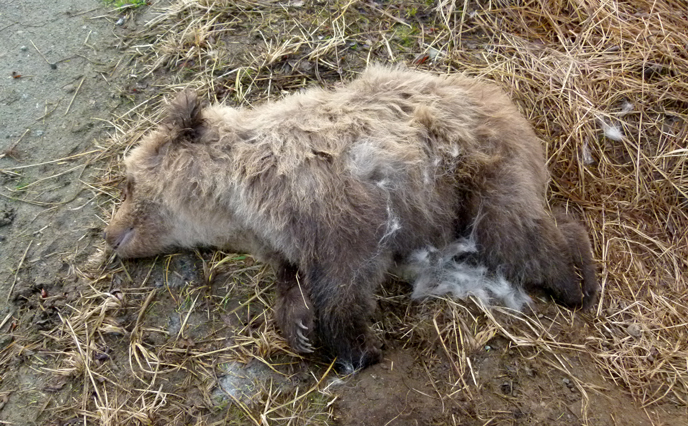 This is how biologists found 451’s dead cub. The tufts of hair were removed by ravens after the cub died. Only after lab analysis were pathologists able to determine the likely cause of death for this cub. NPS photo/L. Skora.
This is how biologists found 451’s dead cub. The tufts of hair were removed by ravens after the cub died. Only after lab analysis were pathologists able to determine the likely cause of death for this cub. NPS photo/L. Skora.
How prevalent is CAV-1 (infectious canine hepatitis) in Katmai’s bears? Is it contagious? What other effects might it have?
Infectious canine hepatitis is a viral disease found worldwide that primarily infects dogs, foxes, wolves, coyotes, and bears. A 1998 study documented about 10% of brown bears on the Alaska Peninsula had the antibodies that indicate they had contact with the virus. Ongoing, unpublished research suggests that recent infection rates may be higher, especially on nearby Kodiak Island. Researchers are currently studying the prevalence of CAV-1 and other diseases in Alaska to determine if their prevalence changes through time. A partial list of effects of CAV-1 on bears can be found at http://wildpro.twycrosszoo.org/S/00dis/viral/Infectious_Canine_Hepatitis.htm.
Does CAV-1 pose a risk to humans?
CAV-1 does not pose a health risk to humans. Humans who handle sick or dead animals should observe routine precautions and wear personal protective equipment, including masks, gloves, rubber boots, disposable or cloth coveralls. Thorough hand washing is also recommended.
Does CAV-1 pose a risk to dogs?
CAV-1 does infect dogs. Prevention of the disease in dogs is through vaccination. Most combination vaccines for dogs contain a modified CAV-2 which creates immunity for CAV-1. No pets or service animals are permitted within 1.5 miles of Brooks Falls, an area referred to as the Brooks Camp Developed Area, but leashed dogs are permitted elsewhere in Katmai. Since all habitats in the park are utilized by brown bears, pet owners who plan to bring their dogs to Katmai should ensure their animal’s vaccinations are up to date.
What killed 868?
868’s cause of death is undetermined. No signs of outward trauma were visible on 868, except for a broken nose (the nose could’ve have been broken when he collapsed to the ground). 10-12 gallons of fluid were present in his abdominal cavity, which is not a normal finding. Initial laboratory analysis was performed by the Wildlife Health and Disease Surveillance Program, Division of Wildlife, Alaska Department of Fish and Game. Tissue samples from the bear were then forwarded from ADF&G and USGS Alaska Science Center on to the USGS NHWC for diagnostic analysis. He tested negative for CAV-1, so it appears that his death is unrelated to the cub’s. 868 also tested negative for canine distemper virus. No parasites were observed in the tongue or abdominal cavity fluid. However, samples from 868 were decomposing rapidly by the time they reached the lab for analysis which may prevent us from ever knowing his cause of death.
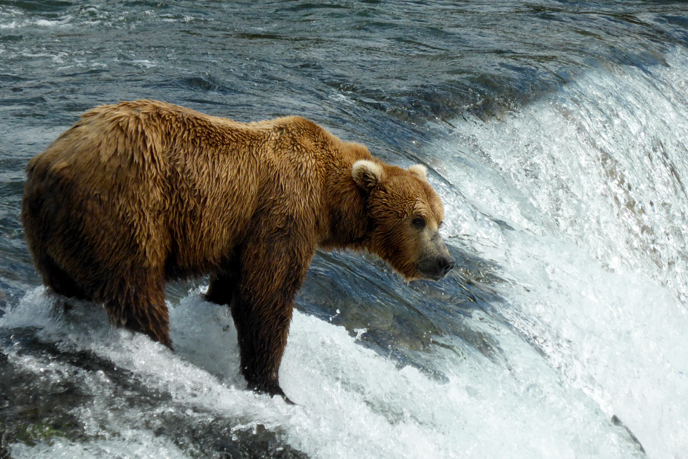 868 was regularly seen at Brooks Falls in July. His death demonstrates that even apparently healthy bears in the prime of their lives can fall victim to disease or illness. NPS/M. Fitz.
868 was regularly seen at Brooks Falls in July. His death demonstrates that even apparently healthy bears in the prime of their lives can fall victim to disease or illness. NPS/M. Fitz.
Why didn’t rangers help the bears?
There are a few reasons why Katmai's staff do not rescue and rehabilitate abandoned, injured, and/or sick cubs. To summarize—
1. Policy: The NPS aims to maintain natural processes in the areas that we manage.
2. Feasibility: There aren’t enough zoos or rehab centers to care for all injured and orphaned bears, nor does the park have the staff or expertise to respond these situations in a timely manner.
3. Expense: It is very expensive to care for these animals.
4. Need: Katmai’s bear population is thought to be healthy enough that we do not need to take measures to increase it.
5. Bears are tough: Most never need our help, even the injured or sick.
Bears need to be given the chance to live like wild bears. If, for example, park staff had captured and sent an injured 89 Backpack to a rehab center in 2007 he’d likely be living a life of captivity instead of the life of a wild bear (read more about his story). If, to cite another example, rangers would have captured 402’s abandoned cub and sent it to a zoo, then it would not have had a chance to get adopted by 435 Holly. We would not have had the opportunity to witness and learn from that rare and unique event. These are fascinating stories that demonstrate bears’ adaptability, resourcefulness, and resiliency. This situation was also complicated by the continued presence of 451, the mother of the cub. It would not have been safe to approach the cub with the mother nearby. Rangers and other park staff realize that it can be hard to watch an injured or abandoned cub struggle to survive, but that is part of the bear world. Given a chance, the lucky, strong, and fit bears will survive to pass on their genes to the next generation and Katmai’s bear population will be healthier for it.
Why was the cub collected for necropsy?
Due to the high profile, unusual nature of the death, and the lack of scientific information on the sources of mortality in young bears, aside from infanticide and starvation, park staff decided the cub should be collected and necropsied.
What samples were taken from 868?
The head, heart, lungs, liver, small intestine contents, blood, abdominal cavity contents and hair were collected from the bear. These were sent to the Alaska Department of Fish and Game and the NWHC with additional samples going to the USGS Alaska Science Center.
What information might be gained from examining the bears?
If the bears’ deaths represented a new disease outbreak, then the examination could also provide important and timely information for wildlife managers across Alaska. By examining the bears, researchers also have the opportunity to:
- Test for rabies and canine distemper. Since rabies can infect humans, it receives a high priority for testing.
- Test tissues for the presence of heavy metals like lead, human made chemicals like propylene glycol (antifreeze), and natural toxins like saxitoxin (the principle chemical that causes paralytic shellfish poisoning).
- Identify and document the presence of parasites like sarcocystis, toxoplasma, nematodes, and trichinella.
After the cub was collected, its mother (451) returned to the spot where it died. Is that normal?
451’s reaction after her cub was collected was not surprising, although it is difficult to predict how mother bears will react towards the loss of a cub. During most instances when rangers and NPS staff have seen a cub die, the death has been quick and it was usually caused by another bear. In some of these cases of infanticide, the mother bears act agitated for a short time before they departed the area and continued to feed and rest as though nothing happened. At other times, mother bears have been observed returning repeatedly to the spot where they lost their cub, even days later. Bears are intelligent and individualistic. These traits probably dictate the broad array of reactions people have observed in mother bears who have lost cubs.
How big was the cub and 868?
The cub weighed 29.7 kg (65.4 lbs), it measured 94 cm (37 in.) from nose to tail-tip, and it measured 68 cm (27 in.) in girth. Measurements for 868 were not taken, but biologists estimated that he weighed 800-900 pounds (362-408 kg).
Will the cub’s remains be returned to Brooks River?
The cub’s hide and skull will be returned to Katmai for educational and interpretive use. The remainder of the cub will be disposed of by the NWHC lab.
What is the risk that 451 and her remaining cub also contracted CAV-1?
According to Susan Knowles, staff pathologist at the NWHC, transmission of CAV-1 occurs via ingestion of infected urine, feces, or saliva. Animals that recover may shed the virus in their urine for longer than six months and the virus can persist in the environment for weeks or months. Bears are often observed investigating feces and urine of other bears, so it is possible that 451 and her other cub are also infected with the disease.
What happened to 868’s body?
After biologists from Katmai National Park and Preserve performed a field necropsy on 868, his remains were left where he had collapsed and died. A short time later, a large bear discovered the carcass and fed on the remains. When NPS employees visited Brooks Camp on November 6, all that remained were the rear legs and portions of the skeleton and hide.
Can I see photographs of the bears?
Yes. Photographs taken at Brooks Camp of 868 and the cub are online. Some photos are graphic.
- Photos of 868
- Photos of the cub (Please note that this link does not load properly in all internet browsers.)
How can I support bear research in Katmai?
Research on Katmai’s bears is ongoing and the park has received several questions about supporting this work. There are many ways to support bears and bear research in Katmai. You can become a volunteer camera operator on explore.org or make a monetary donation to the park. See something interesting on bearcam? Add it to the bearcam wiki page for future reference. When you visit, plan ahead for bear encounters and learn about ways to reduce your potential impact on the animals.
Ongoing research on Katmai’s bears includes the Changing Tides project, a multi-year study to investigate the unique link between the terrestrial and the nearshore environment, specifically between coastal brown bears and intertidal invertebrates. At Brooks River, staff continue to collect data for a long term bear population and habitat use study. Staff also plan to begin a genetics and DNA study on Brooks River bears in 2016. Samples from 868 and 451’s cub were saved for genetic analysis as a part of this upcoming study.
